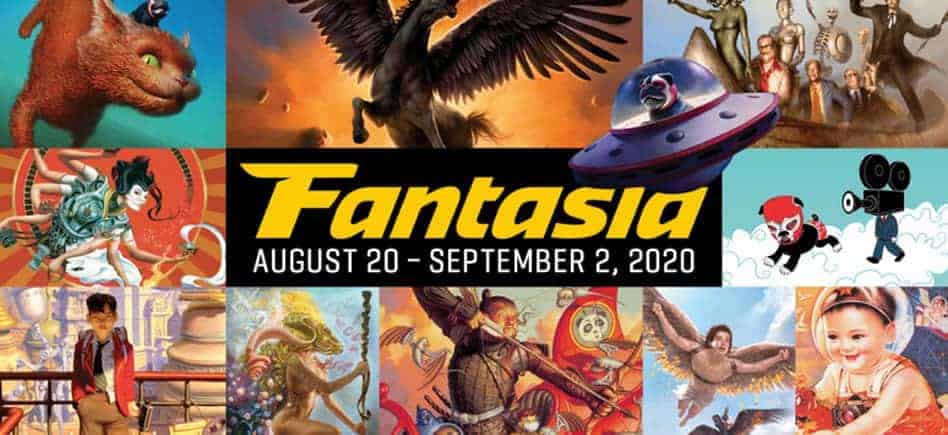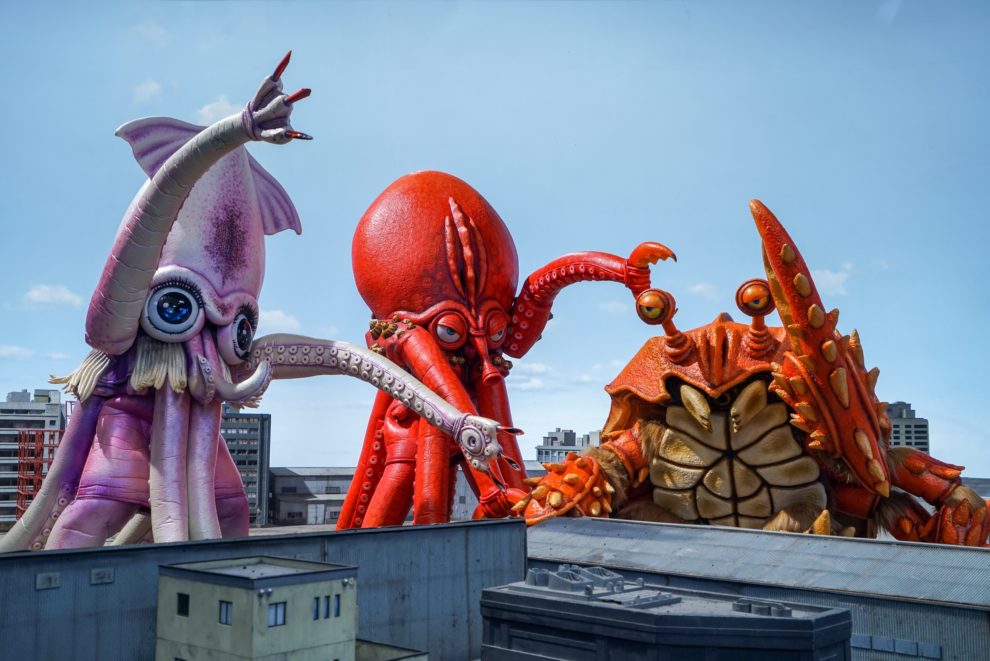Released in Japan in June 2020 and getting its international premiere at Fantasia Film Fest, “Monster Seafood Wars” is Minoru Kawasaki's first film in four years. The film is loosely based on one of the earliest ideas by the SFX legend Eiji Tsuburaya about a giant octopus attacking Tokyo, getting killed with vinegar, and eaten by Tokyoites.
Monster Seafood Wars is Screening at Fantasia Festival

Yuta Tanuma (Keisuke Ueda) is a disgraced scientist-turned-sushi-assistant. One day, while on delivery to the nearby Shinto shrine, Yuta gets into a small bicycle accident and loses his mixed seafood box. Its contents soon turn up in the form of a monster squid and octopus who start wreaking havoc over Tokyo. The two are soon joined by a mutated crab. Realizing the Self-Defence Forces are powerless against the three seafood monsters, nicknamed Ikara, Takora, and Kanira, the government creates a Seafood Monster Attack Team which Yuta is forced to join due to his love for Nana (Yoshida Ayano Christie), another member of the team. The team creates a vinegar gun to fight off the seafood threat and in the meantime finds a secret that changes everything – the monsters are equally dangerous and delicious.
In “Monster Seafood Wars” Minoru Kawasaki pays tribute not only to Eiji Tsuburaya but to the entire kaiju genre. Take for example the other two seafood monsters, the crab and squid which are probably influenced by Ishiro Honda's 1970 film “Space Amoeba.” Not so much as costume designs per se, Kawasaki's huge seafood monsters are way cuter and animation-like than those in Honda's 70s action, but more in choice of characters and some movements. The same tribute to Showa-era giant monster movie tropes can be seen in many other things such as the names of the monsters, Kanira, Ikara, and Takkora, which are a fun nod to the super noncreative naming of monsters like Gamera and Ebira, to the characters, bad-in-a-funny-way acting, and many of the special effects.
The decision for the cute design of the mutated seafood is not something random. It's not played just for laughs, too. Though undoubtedly funny and visually super catchy and cheesy, the real reason for it is the fact that the movie is a funny and somewhat insightful commentary on the contemporary consumer culture where everything is commodified. A culture where the giant beasts razed cities and brought anxiety the nation in the past are turned into nothing more than objects to be obtained and consumed. And in a very primal way at that, as food.
This brings us to the second critique that this super fun movie makes at contemporary culture, namely the worships things as basic and simple as food and the consumption of only surface-level media like food shows, food porn, and other such things. This last element is most notable when the movie changes its tone midway and starts working as a food show rather than the slightly more “serious” mockumentary one it has earlier. But what truly brings the idea home is the final reveal that we, too, have been complicit in this fetishization of food.
It is exactly this subtle critique of society that makes this super fun monster flick special because it harkens back to the classic-era of kaiju films. This is done not only through the exclusive dependence of practical effects and men in rubber suits portraying the giants but also to the main idea of these special effects-heavy movies, namely their functions as a critique of the society and its current ailments.
Though the movie delves into these themes, they are far from its main goal, more like an added bonus or a hidden food for thought. The primary focus is to entertain and dazzle the viewers with awesome suits and fights between men and sea titans. And luckily “Monster Seafood Wars” delivers on that front, too. The three monsters are cute, fluffy, and super agile. In fact, they look more like giant dolls than the menacing monsters of yesteryear. This quality of theirs is reflected in the way they move, too, especially the giant crab Kanira, who moves through impossibly funny sideways jumps. The costumes are nicely designed, too. There are undoubtedly people in them but it is precisely this unapologetically use of “outdated” special effects that makes Kawasaki's movie truly awesome. What's more, it manages to also show the viewer that there is a simple beauty in the use of practical effects that is impossible to recreate using digital means.
Where the movie differs from the classic kaiju films is in the excessive use of green screen. This is somewhat lamentable because the few miniature models that are used in the first act are beautiful and add another layer of tactility to “Monster Seafood Wars.” Though the use of screens is not something unheard of in this genre, a vast majority of Japanese monster films at least from the time of “Godzilla” contain scenes of actors playing in front of a screen, the way it is done here is rather amateur and bad. This is mostly due to the terrible tracing of the actors' contours that leaves a green outline around all of them, resulting in many cheap and ugly looking scenes.
With its interesting and sly observations about current society and awesome nods to classic kaiju films from half a century ago, Minoru Kawasaki's “Monster Seafood Wars” twists the giant monster genre while managing to show its love and respect for it. Yet, it is never self-indulgent in its referentiality, making it a fun watch for kaiju fans old and new.















